Global News: BC advocates raising alarm due to recent clear-cut on Vancouver Island
July 6, 2024
Global News
An old growth advocate group is raising concerns regarding a recent clear-cut on Vancouver Island. Paul Johnson has more.
July 6, 2024
Global News
An old growth advocate group is raising concerns regarding a recent clear-cut on Vancouver Island. Paul Johnson has more.
For Immediate Release
July 2, 2024
Shocking photos and drone footage reveal “old-growth carnage” as trees upwards of 9 feet (3 meters) wide and more than five hundred years old are logged under the management of BC Timber Sales in the famed Nahmint Valley on Vancouver Island, BC. Conservationists are urging the BC government to immediately identify substantial tracts of misidentified at-risk old-growth forests that should be eligible for logging deferrals that may have been missed due to data errors, to provide deferral funding or “solutions space” funding to First Nations to facilitate the protection of these stands, and to implement “ecosystem-based” protection targets. A species at risk, oldgrowth specklebelly lichen, was also documented in the now logged area, potentially for the first time in the Nahmint Valley.
Conservationists with the Ancient Forest Alliance (AFA) have documented the clearcutting of a superlative ancient forest in the Nahmint Valley near Port Alberni in the territory of the Hupačasath, Tseshaht, and Yuułuʔiłʔatḥ First Nations. The clearcut spans 17.4 hectares or roughly 31 football fields and contains scores of giant old-growth trees, including monumental redcedars and rare, old-growth Douglas-fir trees. The cutblock was home to oldgrowth specklebelly lichen, a species at risk found only in old-growth forests, as well as being mapped as suitable habitat for the endangered marbled murrelet. BC Timber Sales (BCTS), the BC government’s own logging agency, auctioned off the forest for logging, and trees are still being felled at the time of this release. The Nahmint is legally designated a Special Management Zone for biodiversity and is famed for its crystal blue river waters, record-sized old-growth trees, diverse wildlife, and high recreational values.
“When I first visited this endangered forest several months ago, I was amazed by its sheer beauty. It was filled with massive old-growth trees, gardens of ferns and wildflowers carpeted the forest floor, and birdsong filled the air. It was like stepping into a lost world,” recounted TJ Watt, campaigner & photographer with the Ancient Forest Alliance. “When we returned last week, it was old-growth carnage. The shattered bodies of ancient cedars lie where a vibrant and biodiverse ecosystem once stood. Premier Eby has shown a willingness to move forward on greater old-growth protection in BC but is still coming up deficient in many areas, and it’s time he directed BC Timber Sales – the BC government’s logging agency and the ones responsible for planning and approving this logging – to lead by example. What we’ve documented here is brutal and will leave many people outraged.”
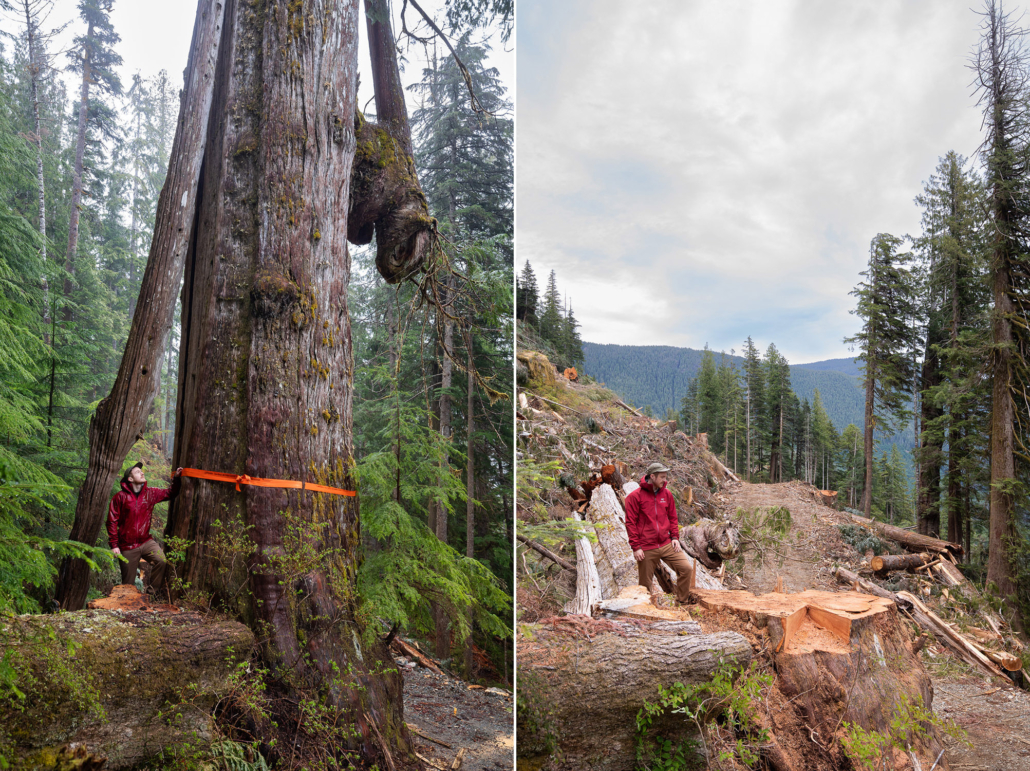
Before and after the logging of an ancient redcedar roughly 9 ft (3 m) wide in the Nahmint Valley in 2024.
Over the past year, the BC NDP government has set the stage to vastly expand the protection of old-growth forests and other ecosystems across BC by allocating and securing significant funding for conservation financing, committing to protect 30% of the province by 2030, creating a draft Biodiversity and Ecosystem Health Framework, and more (see backgrounder below). Several critical government conservation policy gaps and funding needs remain, though, namely deferral funding for First Nations and ecosystem-based protection targets, thus allowing for the continued destruction of the most at-risk old-growth ecosystems. The only path to fully protecting old-growth forests in British Columbia is via First Nations consent and shared decision-making, including on lands managed by BC Timber Sales. However, the BC government can and should facilitate that process by allowing the addition of misidentified at-risk old-growth stands into logging deferral areas, providing deferral funding, and proactively engaging First Nations about potential Indigenous Protected and Conserved Areas (IPCAs) in the high conservation value areas in their territories.
“The monumental stumps and giant fallen logs here in the Nahmint are fresh evidence that major conservation policy and funding gaps remain that the BC NDP government must address,” notes Watt. “We need legally binding ecosystem-based protection targets that would aim new protected areas at the most at-risk ecosystems, such as the big-tree old-growth forests. These could be included in the forthcoming Biodiversity and Ecosystem Health Framework. At least $120 million in dedicated deferral or “solution space” funding is also urgently needed to support logging deferrals by helping offset any lost revenues for First Nations being asked to accept them in their territories, along with proactive efforts from the BC government to identify forests that meet the criteria for deferral but were missed in the initial mapping exercise. These solutions would have presented the greatest opportunity for protecting this forest and others like it, wherever they may be found on the landscape.”
This forest was initially identified as being an at-risk, big-tree old-growth forest by the province’s independent science panel, the Technical Advisory Panel (TAP). However, it was not included in the 2.6 million hectares of priority big-tree old-growth deferrals, likely due to provincial inventory mapping errors that lumped together the areas of big trees with adjacent areas of less productive forest. The TAP specifically identified the issue of inventory errors in their report to the BC government, stipulating that any big-tree old-growth forests that were misclassified in the provincial datasets should be identified through on-the-ground assessments and immediately deferred.
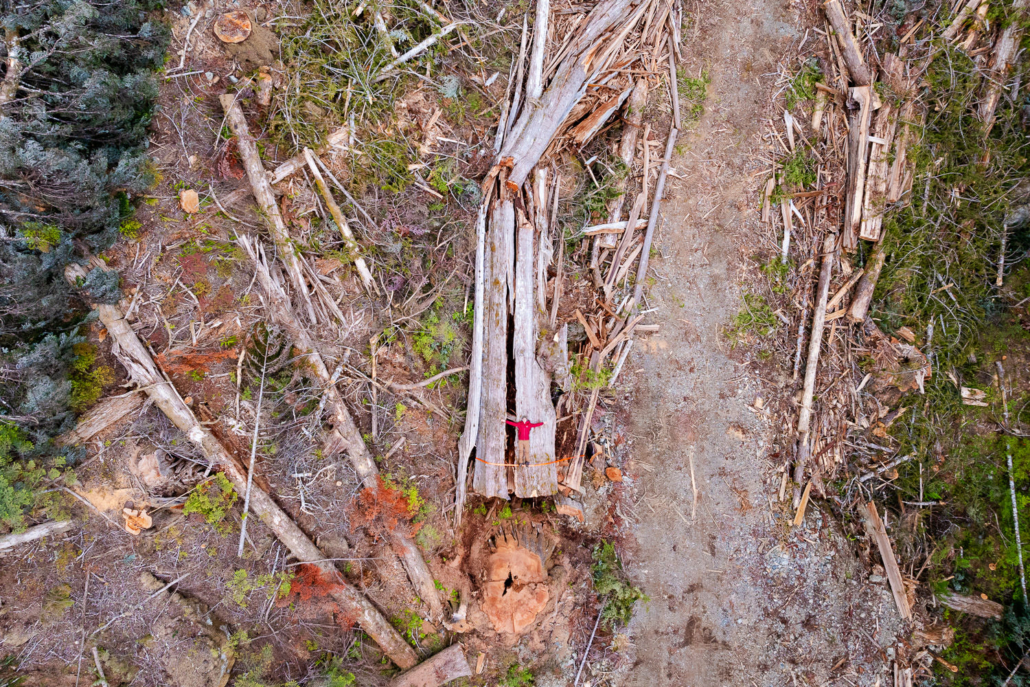
AFA photographer TJ Watt lays atop a giant fallen cedar for scale.
“When it comes to verifying forests for logging deferral, the Ministry of Forests is currently playing a game of old-growth subtraction in favour of the timber industry, facilitating more old-growth logging rather than less,” stated Watt. “As per their current policy, BC Timber Sales is actively using field verification to remove forests recommended for deferral that don’t meet the TAP criteria, but do not use the same practice to identify at-risk old-growth forests that may have been missed for deferral, such this one, so they have a chance at being added in and eventually protected. To help identify these at-risk stands, forest engineers should be legally bound to field-verify planned logging cutblocks against the TAP deferral criteria and report any discrepancies to the BC government so adjustments can be made. Citizens and scientists should also be able to submit the locations of key old-growth stands they’ve identified, which Forest Service foresters would then verify. Government data gaps and an approach that skews towards protecting the least amount of old-growth possible are leading to the loss of irreplaceable ancient forests vital to supporting endangered species, First Nations cultures, the climate, clean water, wild salmon, and tourism. Premier Eby should be instructing government staff to close this conservation loophole immediately.”
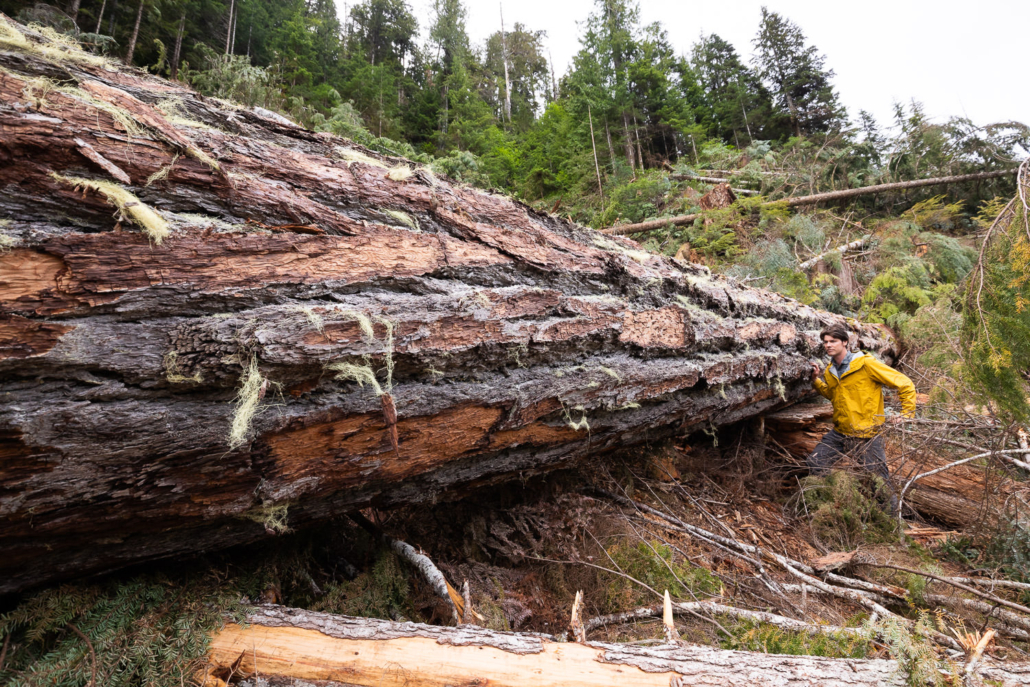
AFA researcher Ian Thomas beside the trunk of an old-growth Douglas-fir tree cut down in June 2024 in the Nahmint.
The Nahmint Valley has long been recognized as a place of exceptional ecological value. The province designated it a “high biodiversity emphasis” Special Management Zone to help protect its old-growth values and safeguard threatened ecosystems. Despite that legal requirement, successive governments have opened the Nahmint up to devastating logging practices, destroying some of the most magnificent forests on earth.
“The Nahmint is a Special Management Zone established to ensure old-growth values are maintained and biodiversity is safeguarded. And yet you see the liquidation of a threatened ecosystem home to countless species, including this rare old-growth dependent lichen species, observed possibly for the very first time in the Nahmint Valley, dying as it was discovered,” noted Ian Thomas, a researcher with the Ancient Forest Alliance. This forest was a rich, priceless ecosystem that is impossible to replace. It wasn’t a big multi-national corporation, but government staff who planned the logging of a forest that contained rare, big-tree old-growth and was home to at-risk species. All of this is in a landscape that is supposedly managed to protect biodiversity. Does the Ministry of Forests believe this is what putting ecosystem health before timber values looks like? If there were anywhere you might expect the promised ‘paradigm shift’ in forest management, it would be here in the Nahmint Valley.”
– See our information explaining the central importance of ecosystem-based targets and forest productivity distinctions.
– See our media release from May 2024 for a comprehensive list of the actions still needed from the BC government to protect old-growth forests and endangered ecosystems in BC.
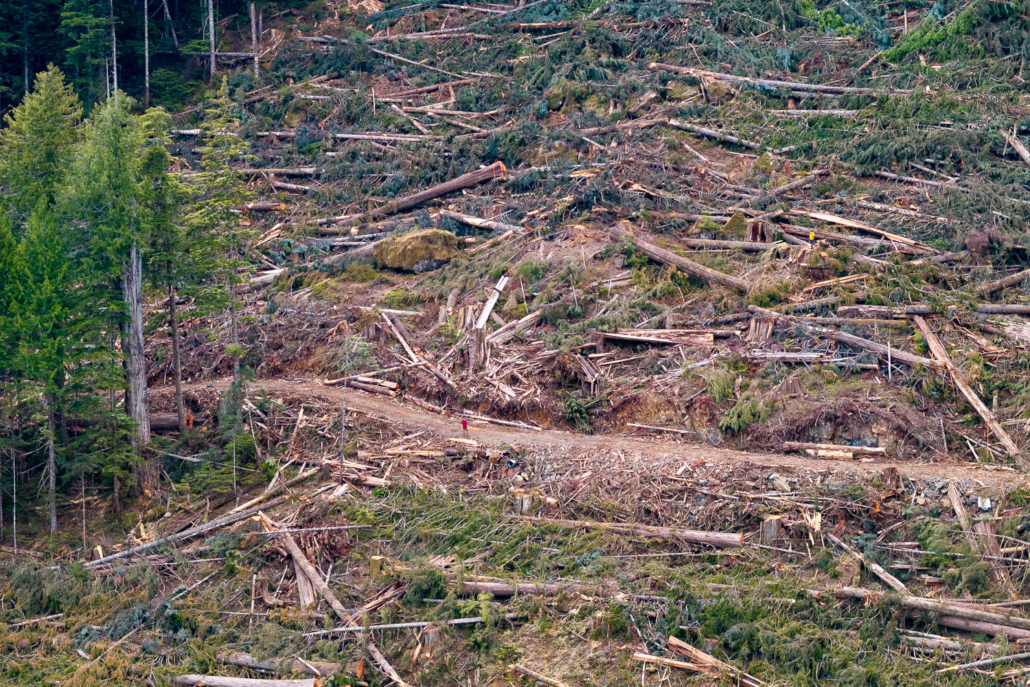
AFA’s TJ Watt (red) and Ian Thomas (yellow) provide scale to the scene of destruction.
The Ancient Forest Alliance has fought for years to ensure greater protection for the old-growth forests in the Nahmint Valley. In 2018, the Ancient Forest Alliance exposed the logging of hundreds of hectares of spectacular ancient forests, including some of the largest trees in Canada. Ancient Forest Alliance filed a complaint with the independent BC Forest Practices Board, which found that the provincial government failed to adequately protect the exceptional ecological values of the Nahmint. In 2021, the resulting report from the independent Forest Practices Board found that the province was failing to adequately safeguard the ecological health of this Special Management Zone.
In 2022, the BC government released a draft landscape unit plan for the Nahmint Valley, placing some additional areas of old-growth forest into landscape reserves such as Old-Growth Management Areas. Though a welcome step, this planning was carried out under the previous paradigm where conservation could not significantly impact timber harvesting. As a result, the findings of the Technical Advisory Panel were not considered, and only about 30% of the productive forests were put into conservation reserves. Biologists agree that when ecosystems fall below 30% of their original extent, they are at high risk of irreversible biodiversity loss, and at least 70% of the original old-growth forests should be protected from logging to ensure long-term ecosystem health. In the Nahmint Valley, additional old-growth groves, including forests explicitly recommended for deferral by the Technical Advisory Panel that should have been protected in the draft landscape plan, are already planned for logging. Should BC Timber Sales’ future plans move forward, it will further fragment and destroy the old-growth forests of this remarkable valley.
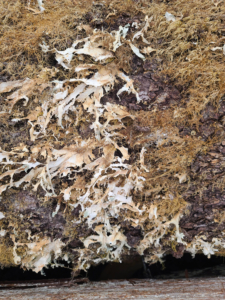
AFA has now documented what is likely the first known occurrence of old-growth specklebelly lichen in the Nahmint Valley (according to the page 21 summary list of known locations from 2015). Oldgrowth specklebelly lichen is federally and provincially listed as a species at risk, with only 52 known colonies in Canada. The highly sensitive lichen species depend on the humid microclimate of intact old-growth forests. The specimens observed were already dead or dying in the exposed clearcut. A photo of the lichen, which had lost much of its bluish colour after being in the sunlight, was sent to expert lichenologist Trevor Goward, who confirmed its presence. The provincial recovery plan for the species calls for the protection of each of these rare colonies from logging in order to “maintain all known extant populations and any future populations that may be found in British Columbia.” However, no formal legal protection exists.
Across BC, the BC NDP government has taken historic strides toward expanding the protection of old-growth forests and other endangered ecosystems across BC, such as securing over $1 billion in federal-provincial funding through the BC Nature Agreement, creating a $300 million conservation financing fund, committing to expanding protected areas in BC to 30% by 2030, drafting a Biodiversity and Ecosystem Health Framework still currently under development, and now undertaking discussions with dozens of First Nations on potential new Indigenous Protected and Conserved Areas (with several major protected areas recently announced, including ten new Conservancies in Clayoquot Sound and a 2000 square kilometer new Klinse-za/Twin Sisters Provincial Park in the far north). However, without dedicated “ecosystem-based” protection targets, in general, the most threatened and biodiverse ecosystems will continue to be largely excluded from new protected areas, which will focus on less-contested ecosystems at higher elevations and in the far North.
Old-growth forests support endangered species, First Nations cultures, the climate, clean water, wild salmon, and tourism. Under BC’s current system of forestry, second-growth tree plantations are typically re-logged every 50–60 years, never to become old-growth again.
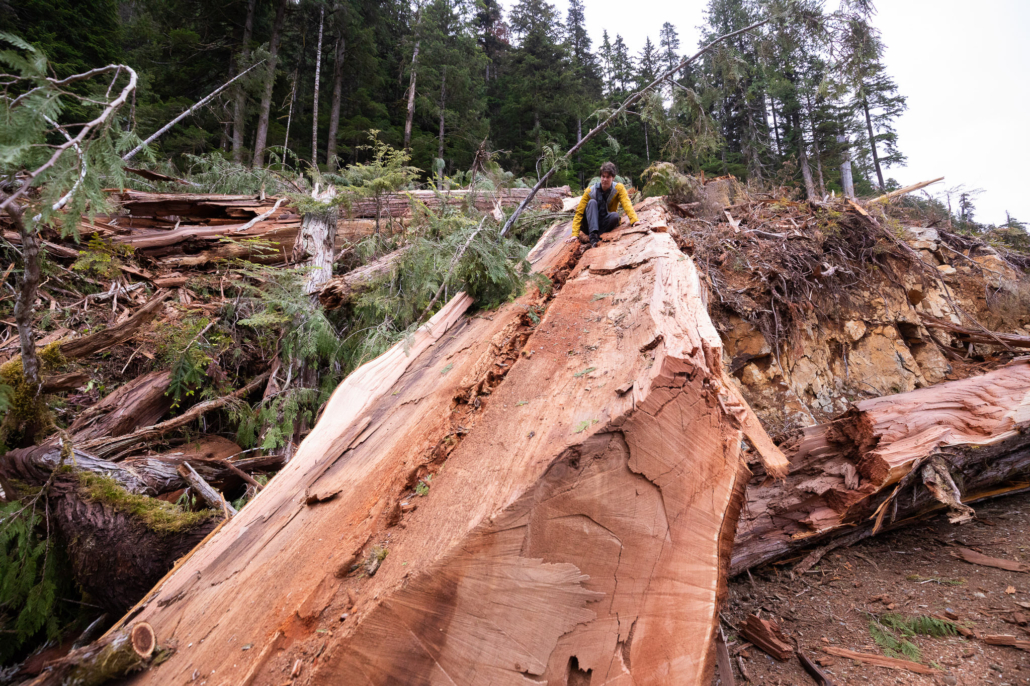
CTV News Vancouver Island
May 13, 2021

The Forest Practices Board says the investigation stemmed from a 2018 complaint about BC Timber Sales licensees’ logging of large old-growth trees in the Nahmint River watershed near Port Alberni. (CTV News)
VICTORIA — An investigation by British Columbia’s forest practices watchdog has found the provincial agency responsible for auctioning timber sale licenses did not adequately protect old forest in an area of Vancouver Island.
The Forest Practices Board says the investigation stemmed from a 2018 complaint about BC Timber Sales licensees’ logging of large old-growth trees in the Nahmint River watershed near Port Alberni.
Board chair Kevin Kriese says the findings show BC Timber Sales’ forest stewardship plan is not consistent with specific biodiversity objectives that are legally required under the Vancouver Island land use plan established two decades ago.
Kriese says more detailed landscape planning was supposed to provide clear direction on how much and where to conserve old and mature forest, but that planning was never completed and the forest stewardship plan should not have been approved.
He says BC Timber Sales was left with a complicated set of legal objectives to interpret, and the board found it missed important details required to manage for biodiversity in the Nahmint.
The Forests Ministry says it appreciates that the board acknowledged old and mature forests make up 67 per cent of the Nahmint area, and BC Timber Sales’ operations are addressing its recommendations.
The board’s report recommends that BC Timber Sales not sell any licenses in areas of “high-risk” ecosystems until the province finishes landscape planning to specify the amounts of forest to retain.
“We looked at the remaining forest in the watershed and found there are some ecosystems that could be at risk if more logging takes place in them,” Kriese says in a statement Wednesday.
The ministry says in a statement it’s updating the Nahmint landscape plan and adjusting old-growth management areas to “better capture rare and under-represented ecosystems and biodiversity targets.”
The updated landscape will come into effect soon, it says.
The board also determined that an investigation started by the Forests Ministry’s compliance and enforcement branch was reasonable. But it was cut short because the branch did not actually have the power to ensure the required objectives of higher-level land use plans are met.
The board is recommending the government fix that gap, Kriese says.
“The current legal framework does not permit government to ensure that (forest stewardship plans) approved in error can be amended, and this does not give the public confidence in government’s compliance and enforcement.”
The Nahmint River watershed is within the traditional territory of the Nuu-chah-nulth people and spans just shy of 200 square kilometres.
The Forest Practices Board says its investigation was triggered when members of the environmental organization Ancient Forest Alliance saw BC Timber Sales’ licensees harvesting large, old trees in 2018.
The Nahmint Valley is considered a “hot spot” for old-growth trees with high conservation value, the alliance says in a statement.
The alliance says it complained to the board after members found very large old-growth trees had been cut in the area, including ancient cedars and the ninth-widest Douglas fir recorded in Canada.
Read the original article
Forest Practices Board investigation into Ancient Forest Alliance complaint reveals non-compliance by BC government logging agency in Nahmint Valley, putting ecosystems at risk, and systemic flaws in BC’s forestry legislation.
For immediate release
May 12, 2021
Victoria, BC – BC Timber Sales’s logging plans for the Nahmint Valley have consistently failed to comply with legally-binding land-use objectives for biodiversity protection, according to a long-awaited Forest Practices Board report following an investigation into old-growth logging in the Nahmint Valley near Port Alberni on Vancouver Island.
The report, released today, comes three years after the Ancient Forest Alliance (AFA), together with members of the Port Alberni Watershed Forest Alliance, exposed the clearcutting of some of Canada’s grandest remaining old-growth forests and biggest trees – including Canada’s ninth widest known Douglas-fir – in the Nahmint Valley, located in Hupacasath and Tseshaht territory. The discovery prompted the AFA to submit a complaint to the Board, as well as the Ministry of Forests’ Compliance and Enforcement Branch (CEB), in summer 2018.
The Board’s nearly three-year investigation confirms one of the key findings from the CEB investigation – that BCTS’s 2017 Forest Stewardship Plan (FSP) for the Nahmint Valley fails to comply with legal biodiversity objectives set under the Vancouver Island Higher Level Plan Order.
“With the Forest Practices Board’s investigation now complete, the evidence is irrefutable: BC Timber Sales are failing to adequately protect old-growth in the Nahmint Valley,” stated Ancient Forest Alliance campaigner Andrea Inness. “This failure exposes the gross inadequacies and lack of accountability that are inherent in BC’s forest system and the need for immediate, systemic change.”
The Board’s investigation found that BCTS did not follow good conservation design, use available ecosystem mapping, or ensure forest ecosystems were adequately represented at the landscape level through Old Growth Management Areas. As a result, not only is BCTS’s FSP non-compliant, according to the Board’s report, these issues have “occurred over a long period of time and are creating real risks to ecosystems.”
“BCTS has logged too much old-growth forest in some ecosystems, including in rare and underrepresented plant communities, putting biodiversity at risk,” stated Inness. “What’s worse is they have no plan in place to ensure even more of these forests aren’t destroyed.”

Despite these issues, the FSP was given ‘rubber stamp’ approval by the district manager and when the CEB’s investigation identified possible compliance issues in fall 2018, nothing was done to amend the FSP to bring it into compliance.
The Board’s report also reveals inherent inadequacies in the Forest and Range Practices Act – namely that there is no mechanism through which changes can be made to non-compliant FSPs once they’re approved – and loopholes that allow forest companies to substitute younger, smaller trees for older, bigger trees in retention areas, combine protection targets for old-growth and mature forests together, and stack forest reserves like Old Growth Management Areas and Wildlife Habitat Areas on top of each other.
“BC’s deeply flawed forest system not only lacks accountability, it allows forest companies and BCTS to protect the lowest possible amount of productive old-growth forests while always targeting the very best stands for logging,” stated AFA campaigner and photographer TJ Watt.
“At the end of the day, it’s not enough that BC Timber Sales amend their landscape unit plan and their FSP, as the Board suggests, so they can continue logging old-growth while adhering to BC’s outdated and inadequate forestry laws. Those laws need to be revised to reflect advancements in conservation science and the ecological crisis facing BC’s ancient forests.”
“Public trust in BC Timber Sales is already abysmal,” stated Inness. “Knowing they’re failing to meet the BC government’s grossly inadequate standards for old-growth protection is further proof of the urgent need for sweeping, systemic change in BC’s forest system.”
In its 2020 report, the NDP government-appointed Old Growth Strategic Review Panel concluded that productive old-growth forests are endangered across most of BC and a complete paradigm shift in BC’s forest sector, as well as immediate steps to protect the most at-risk old-growth forests, are urgently needed. In October, Premier Horgan committed to implementing the Old Growth Panel’s recommendations “in their totality,” but very little has been done thus far and the province is falling far behind on the panel’s suggested timeline.
In light of the panel’s recommendations and the Board’s findings, the AFA is calling on the BC government to direct BCTS to immediately stop auctioning off cutblocks in old-growth forests and instead champion conservation solutions and sustainable second-growth harvesting practices.
Brenda Sayers of the Hupacasath First Nation in Port Alberni is also urging the province and BC Timber Sales to end the destructive logging of old-growth in the Nahmint.
“The Nahmint Valley is not only beautiful, its ancient forests and biodiversity are critical to our people’s culture, our identity. Yet, the BC government is sanctioning the destruction of these ecosystems through its own logging agency, which have shown themselves to be incapable of responsibly managing our sacred lands.”
“The province needs to enact the paradigm shift that Premier Horgan committed to last October so that biodiversity and ecosystem integrity – which are what sustain First Nations cultures – are given the highest priority, not just in the Nahmint, but everywhere in BC.”
Background information
Receive campaign updates, old-growth photo galleries, news about AFA events, ways to take action, and more!
